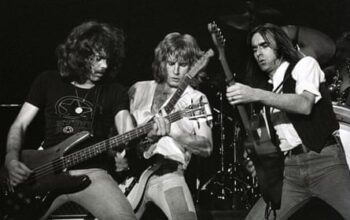I
I initially met Sinéad in 1985, when she had recently worked with The Edge from U2 on a track called Heroine. I saw her at a gathering at his residence and when she entered the room draped in a long cape, it was a sight to behold. Time seemed to stand still. Her presence was more than just her physical appearance, there was a certain depth to her. And when she began singing, I was blown away.
I hadn’t seen her for quite some time after that. Later, in 1993, I collaborated with director Jim Sheridan on the soundtrack for his movie In the Name of the Father, which focused on the Guildford Four. Bono and I had both recorded versions of the song “You Made Me the Thief of Your Heart” for the film, but Jim felt they were too somber. He wanted a female voice for the song and I recommended Sinéad.
I presented the preliminary version of the movie to her and she was completely willing to record a song for it. We recorded the song at a demo studio in Temple Bar in Dublin. Sinéad came dressed in all denim and carrying a baby doll. It was unclear if she was pretending or not. When I asked about the doll, she replied, “It’s my doll – I didn’t have one as a child and now I do. Her name is also Sinéad.” This caused the other musicians and producer to leave the room immediately.
I recall that she dedicated a significant amount of time preparing for the session. She carried a large bag filled with candles and carefully placed them around the small studio. Before we started, she mentioned wanting to have a drink together to discuss the lyrics, so we went to a nearby bar in the Clarence hotel. She requested a pint of Guinness and, after just a few sips, asked for another one. I was unsure of the situation, but I ordered her a second pint. When I brought it back to the table, she immediately picked it up, walked to a corner alcove, and poured it slowly onto the head of a well-known Irish tabloid journalist while shouting at him to never write about her family again.
The situation was quite unexpected – it was as if Bambi had transformed into Darth Vader out of nowhere. But then she returned and sat down, asking me about the song’s lyrics. What stood out to me was the intense anger in her eyes, yet also the sense of determination.
We returned to the studio around 10 PM and she successfully recorded the vocals by midnight. After a few warm-ups and two full takes, it was perfect. Then she left. This marked the beginning of our friendship. The song was later nominated for a Golden Globe, but at the time, just a few months after she tore up the pope’s photo on Saturday Night Live, her music was not receiving much airplay, particularly in America.
Around 2006, Sinéad returned to Ireland and I started spending more time with her. She purchased a home in Bray and we would often meet at Ragazzi’s pizza restaurant in Dalkey village. She would order pints of Coca-Cola and we would chat about her children. I felt a strong sense of protectiveness towards her, almost like a father figure. I believe she sensed this and appreciated it.
In 2011, when I launched my album “Catholic”, she was upset with me for not inviting her to sing on it. We performed together at the Olympia in Dublin and it was a fantastic experience. I recall her children running around during the sound check and I had to ask her to control them, as no one else was doing so. She had a well-known reputation for being able to shift quickly from being calm to confrontational, but not with me. We had a very effortless relationship.
During Sinéad’s difficult times in recent years, it was challenging to get in touch with her due to her frequent changes in phone number and email. I would occasionally receive random messages from her, but then there would be periods of silence. Following the passing of her son Shane, I attempted to reach out through mutual acquaintances, but was unable to reach her. It was a heartbreaking situation and I didn’t see how she could possibly overcome it.

At around 7pm, I was tuned in to an arts show on the radio when they shared the news of her passing. My emotions overwhelmed me upon hearing this. I recall all scheduled programmes being cancelled on the radio stations, with only her music being played. As I went for a walk, I could hear her songs playing from open windows of homes. It felt like a community gathering to honor her life, happening spontaneously.
I believe that Sinéad gained fame at a young age, which became overwhelming for her. However, she also desired to be in the spotlight. It was a complex situation as I was displeased with the Irish media for painting Sinéad as unstable, but then attempting to glorify her as Diana, Princess of Wales after her passing.
I shared a similar viewpoint to approximately 90% of what she expressed regarding the state of the world, particularly in relation to Ireland. I personally had strong opposition towards the Catholic church when I was younger, but she possessed the notability, influence, and bravery to speak out against it more effectively. As a social campaigner, she was ahead of her era. To me, it was the everyday women who showed up on the streets to mourn her passing that truly demonstrated her significance. Numerous had quietly endured horrific experiences in Catholic-dominated Ireland. It was evident how much she resonated with them.
What remains ingrained in my memory is the untamed quality of her natural singing ability. Whenever she performed a song by someone else, she didn’t simply imitate it, she owned it. Take a listen to her rendition of Nirvana’s All Apologies – the innocence in her vocals and how she fully embodies the lyrics. The only thing that kept her rooted was music, but unfortunately, it couldn’t rescue her.
Source: theguardian.com


